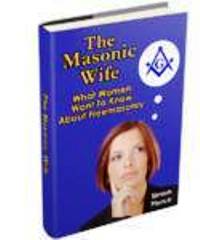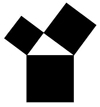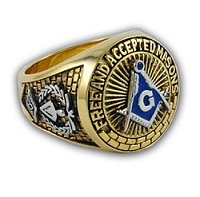Masonic Symbols
Demystifying Masonic Symbols
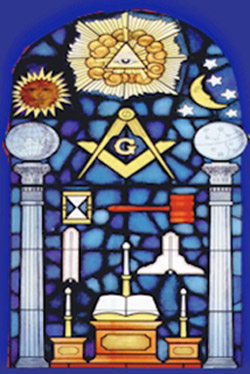 Masonic Lodge Symbols
Masonic Lodge Symbols
To more fully understand Masonic Symbols, it is necessary to learn a bit of the history behind them as well as the difference between a symbol and an emblem.
If you're pressed for time, you can go directly to
Freemason Symbols, however for a truer understanding of why Freemasons use
symbols, please continue reading this, first.
Many Freemason symbols teach moral lessons through the use of allegory. (Allegory is when you liken one thing to another thing).
Learning the allegorical meanings of Freemasonry's many symbols is not difficult, but it can be easy to confuse the difference between a symbol and an emblem. Some writers use these two words somewhat interchangeably and it is easy to see why.
WHAT IS A SYMBOL?
Symbols represent a more complex idea by use of the "face value" of a graphical image.
A symbol compares one thing with another using a graphical, visual object as a memory aid. A symbol has both a visual "face value" and a secondary more complex meaning which has been ascribed to it. In other words, a symbol brings to mind a "story" behind it.
Masonic symbols usually have a secondary or higher religious or spiritual meaning ascribed to them.
Example:
The Masonic setting maul symbol has the face value of its basic use to an operative Mason as that of a tool to set stones.
To speculative Masons, it has a secondary meaning which represents a more complex idea or concept such as the manner in which Hiram Abif met his death.
WHAT IS AN EMBLEM?
Emblems represent a specific group, quality or type.
Emblems have a "face value" only. Most of the time, you can remember the difference if you think: Emblem = Group.
An emblem is an insignia, crest, patch,...a trademark or logo. It is a special design or visual object representing a quality, type or group.
The Masonic square and compasses emblem represents Freemasonry as a group. It is their logo. It should also be noted that the Masonic square and compasses logo is copyrighted.
 Masonic Square and Compasses Emblem with a "G"
Masonic Square and Compasses Emblem with a "G"
The Eastern Star emblem, below, represents a group known as the Eastern Star or the Order of the Eastern Star. It is their logo.
The easiest way to remember the difference between Masonic symbols and
Masonic emblems in Freemasonry is that Masonic emblems are most often used as a
representation or logo for a group. It represents the group as
a whole.
Other appendant bodies within Freemasonry have their own emblems, such as
Rainbow Girls, Job's Daughters, Scottish Rite, DeMolay, etc. These are their logos.
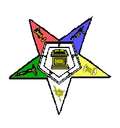 Eastern Star Emblem
Eastern Star Emblem
 Rainbow Girls Emblem
Rainbow Girls Emblem
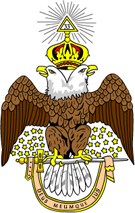 Scottish Rite Emblem (wings down, representing the Southern Jurisdiction)
Scottish Rite Emblem (wings down, representing the Southern Jurisdiction)
 DeMolay Emblem
DeMolay Emblem
If you always have trouble remembering the difference between an emblem and a symbol, the easiest way to remember this is to just remember that (for the most part), emblems are logos.
If you would like to learn more about Freemason emblems, here is more information about Masonic Emblems .
Ancient Symbols
While we don't usually take the time to think about it, we begin learning symbols from the time we are a child. This is just as true for people of every culture around the world, today as it was thousands of years ago for the ancient Egyptians, the Romans, the Greeks, the Hebrews and all the other people of the world.
Egyptian hieroglyphic symbols are famed for their antiquity. Scholars and historians are still attempting to decipher many of these symbols, some of which, in similar formats are used within Freemasonry, today, such as the Point Within a Circle, the Sun, Moon, etc.
Some believe that Moses brought the knowledge of these symbols with him after the Hebrews left Egypt.
Roman Symbols: The Romans developed a numbering system we call "Roman numerals", which is still in use, even today.
Greek Alphabet: The Greek alphabet descends from the Phoenician alphabet. These alphabetic symbols are used today in mathematics and science.
The names of college fraternity and sorority houses are often named using the symbols of the Greek alphabet. The Greek alphabet was the forerunner to other alphabets such as Latin, Gothic and Cyrillic alphabets.
Why are ancient symbols important to Freemasons, today?
The Old Testament of the Holy Scriptures was written first in Hebrew, (plus 8 chapters which were written in Aramaic). In approximately 250-50 B.C., the Hebrew text was translated to Greek (called the Septuagint Bible).
In approximately 400 A.D., the Greek translation was translated into Latin (called St. Jerome's Vulgate Bible).
(For more information about the different Bibles throughout history, see Freemasonry and the Bible).
Phoenicia is the ancient name for the country we now know as Lebanon. The city of Tyre, Lebanon is best known to Freemasons as the city in which Hiram Abif resided before he was called into the employ of King Solomon.
(For more information about Tyre, Lebanon, see Masonic Blue.)
Q: Why is that of any importance, today?
A: Many Masonic symbols are a part of the
shared history of the world.
Some Masonic symbols originated in the Holy Scriptures, which was originally written in Hebrew. A few of them are:
Boaz and Jachin:
The ornate pillars which stood on both sides of the entrance to King Solomon's temple; (1 Kings 7:13-22)
Acacia:
The Holy Scriptures tell us that acacia was used to construct most of the sacred furniture and the tabernacle within King Solomon's temple. (Exodus 25:10 and Ezekial 27:19)
King Solomon and his Master Masons (1Kings 5:15-17)
The Altar of Incense (1 Kings
6:22)
Others are of unknown origin and date.
Masonic Symbols in History
Masonic symbols such as the
double-headed eagle used by the Scottish Rite are steeped in antiquity.
The double-headed eagle appears on the Coat of Arms of many different countries,
as well as several national flags.
The double-headed eagle symbol may also be seen on the flag of the
Greek Orthodox Church. The Holy Roman Empire and the Byzantine Empire, too, both used the double-headed
eagle as an emblem of their rulership.
Q: Does that mean that Masonic symbols such as the double-headed eagle are emblematic of rulership within Freemasonry?
A: No.
Q: Does that mean that Freemasonry's double-headed eagle has anything to do with
the Greek Orthodox Church?
A: No.
Q: Does that mean that the Greek Orthodox Church's double-headed eagle has anything to do with Freemasonry?
A: No.
The symbolism for each entity using the double-headed eagle is quite different,... just as different as each entity is from one another.
It is important to realize that most Masonic symbols did not suddenly appear
with the advent of speculative Freemasonry in 1717. As you can see, above,
many (not all) of the
Masonic symbols we learn, today, go back thousands of years, quite literally into the mists of
time.
This is where for many people, Freemasonry becomes erroneously confused with
ancient secrets, evil and other convoluted beliefs.
Hebrew Symbols From The Holy Scriptures
The first 5 books of the Holy Scriptures (Old Testament) were originally written in Hebrew (in the Torah). As a percentage of the world's population, few people around the world speak the Hebrew language, today. Therefore, because of this lack of knowledge, many people fear the meaning of symbols with which they are not familiar.
Unfortunately, this fear sometimes translates quite quickly from a fear of the unknown to an unfounded fear of evil. Evil has no part within Freemasonry.
An excellent example of this is the Masonic symbol, below.
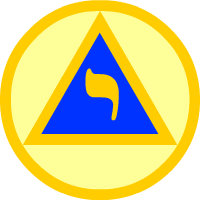 Lodge of Perfection Symbol
Lodge of Perfection Symbol
This is the symbol for the Lodge of Perfection within the Scottish Rite of Freemasonry.
Scottish Rite Freemasonry degrees are advanced Freemason degrees (in the United States) which a Freemason may choose to attain once he has obtained his Master Mason degree.
The golden symbol at the center on a blue
background (which looks somewhat like a flame blowing in the wind) is the Hebrew
letter "Yod".
Yod is the first letter of the sacred name of the Supreme
Being (YHWH) in the original Hebrew from which the Bibles of today have been
translated.
The name of YHWH "Yahway", also pronounced as "Jehovah". The "J" is pronounced as a "Y" which would be "Ye-Ho-Vah". YHWH is written in Hebrew in
The Dead Sea Scrolls and is used approximately 7000 times in the Bible,...more
than any other name for God.
 YHWH
YHWH
These 4 letters (YHWH) represent the current, past and future tenses of the
Hebrew word for "to be".
HVH (pronounced Hovah) means "to be".
HYH (pronounced Hayah) means "was".
YHYH (pronounced Yi-yeh) means "will be".
Therefore, God has always been, is now, and
will always be
The Supreme Being was, is and will always be at the heart of Freemasonry and a
part of our Masonic symbolism.
Q: Does this mean I would have
to learn or
understand the Hebrew language to be a
Freemason?
A: No. Most Freemasons do not know Hebrew.
Q: Does this mean that only those of the Hebrew or
Jewish faith can be Freemasons?
A: No. Freemasonry extends its hand of friendship
to men from all religions around the world.
Q: Does this mean that mostly
Hebrew or Jewish
people are Freemasons?
A: No. The fraternity of Freemasonry has members
from all faiths.
Most Freemason symbols do not require any knowledge of the
Hebrew language. The reason I discuss this Masonic symbol is because
Freemasonry has its roots in the Holy Scripture. The Holy Scripture was
originally written in Hebrew.
Q: Why do you call it the Holy
Scriptures instead of
the Bible?
A: The Holy Scripture
encompasses not only
Christian Freemasons, but members of other
religions.
Q: If I want to become a
Freemason, what do I need
to do?
A: In most jurisdictions, you
need to believe in a
Supreme Being, be a male and be over 21 years
of age. In
most jurisdictions in the United States,
you must request to become a member.
In other parts of the world, a
member or
members of a lodge may ask a prospective
member if he would like to join their lodge. (Click
on the
link at the bottom of this page if you are
interested in more information about how to
become a Freemason.)
Q: Why do Freemasons call God
the "Supreme
Being" or the "Supreme Architect" of the
Universe?
A: Freemasonry is not a
religion. The fraternity of
Freemasonry embraces men from all religions.
Different
religions call the Supreme Being by
different names, such as God, YHWH, Jehovah, I
Am That I Am (as God spoke to Moses) and many
others. All men understand the
words
"Supreme Being" as a word representing deity.
Ancient Symbols in History
Some of the symbols that we know, today, as Masonic symbols are to be found in ancient cultures and in some schools of thought in more recent times, notably those of the Rosicrucians, the Hermeticists, the Kabalists, as well as the mystic and occult schools of thought such as the Gnostics, the Pythagoreans and the Neo-Platomists.
It is within these ancient mystic and occult schools of thought that mystical beliefs and alchemy also become confused with Freemasonry.
Many of these ancient symbols are interwoven through the ages into the history of Man and therefore, due to Freemasonry's antiquity, by default, they have also been woven into the history of Freemasonry.
Masonic Light Begins With Masonic Symbols
Your quest for Masonic light (knowledge) is a journey which will take you on many fascinating paths back through history.
Like any traveler, it is just as important that we learn about different cultures throughout different eras as it is to learn about and visit other jurisdictions within Freemasonry. While on the journey, it is also important that we do not lose our way.
While all knowledge is good;... just as the North Star has been used for milleniums (thousands of years) to guide travelers home, we must also remember that as a traveler, w must not get so caught up in any one of these ancient schools of thought so deeply that we forget to look up and let the star's light chart our way home.
One of the take-home lessons of Freemasonry is that the Masonic student should not only learn the meanings of Masonic symbols, but also remember that we are simply visitors to the historical information we read.
In that sense, we must remember that different Masonic authors may sometimes imply slightly different meanings gleaned from their own perception and understanding of that ancient body of knowledge which may not perfectly agree with meanings gleaned from other authors throughout history. This holds equally true for different jurisdictions around the world.
Masonic Symbols Usage:
It is also important to know that an earlier usage (within history) of the same symbol is not necessarily the source of its Masonic symbolism interpretation...even when the earlier explanation of what we recognize as one of our Masonic symbols is similar to our known Masonic interpretation.
It is also necessary for all Masons to know that there are slight deviations in Masonic symbol meanings across different Masonic jurisdictions around the world. One example of this is that Freemasons in the United States speak of the trestle board.
Freemasons in England and Canada speak of it as a "tracing board". Neither are wrong, (depending upon the jurisdiction).
In different jurisdictions around the world, slightly different Masonic working tools (with somewhat different symbolism) are also used. These tools, too are correct within their jurisdiction.
Noted Masonic Symbologists
Each of the authors, below have attempted to personally explain Masonic Symbols. Since this is a Masonic education website, each of the hyperlinks, below will take you to an online book seller where, if you would like to acquire a more in depth knowledge about Masonic symbols, you may purchase these books written by these Masonic scholars.
- Albert Gallatin Mackey: The Symbolism of Freemasonry: Illustrating and Explaining its Science and Philosophy, its Legends, Myths and Symbols
Specialty Symbols
Visual learning has been with us for thousands of years. The cavemen drew symbols. The Egyptians created hieroglyphics. In fact, we are so surrounded by symbols in our everyday lives and have grown so used to them that we even take them for granted.
In addition, symbols have been so ingrained in us as a part of our education that we have forgotten when, where or who taught them all to us.
Alphabetic Symbols: Each letter of the alphabet is the symbol
for a certain sound...."A" stands for "apple", "C stands for "cat". From
our earliest learning as a child, we are instructed that it is easiest to learn
a particular sound when we can see the physical symbol which it represents.
Driving and Transportation Symbols:
A red light means "stop". Most highway signs, too, are represented by
symbols such as the use of arrows and the use of different colored signs to
denote different actions, such as yellow, green and red signs.
Musical Symbols: If you play an
instrument, you will need to learn musical symbols.
Computer Symbols: Every single key on your keyboard and all
of the icons on your computer screen's toolbar are also symbols. They
liken one thing with another...using a graphical, visual object as a memory aid
such as this e-mail symbol. Even web graphics are symbols. Depending on the
type of career or specialty field we have chosen to embrace, we acquire a new
set of special symbols. The list of specialty symbols is endless.
A: Symbols provide Man with the fastest way to It is no wonder then, that Freemasonry, like many other organizations
throughout history, has its own set of specialty symbols
which compare one thing with another as a memory aid. This is the foundation on which Masonic degrees "Make Good Men Better".
![]() "A" for Apple
"A" for Apple![]()
![]() Musical Notes Symbol
Musical Notes Symbol![]()
Electrical symbols, construction symbols, cartographer
(map makers) symbols; ...we all learn thousands of symbols throughout our lives.
Q: Why Do So Many Symbols Abound?
learn.
Q: Are Masonic symbols mystical?
A: No more so than other specialty subsets of
symbols.
However, due to the fact that the
Supreme Being is central to Freemasonry, many
Masonic symbols such as the Masonic Altar, the
Eye of God and others have Deity (the Supreme
Being) as their central focus.
In your ongoing quest for knowledge via this free online education website about Freemasonry, this link has more in depth information about the history of Masonic Symbols as well as links to specific Freemason Symbols.
I hope you have found this information to be helpful to you as you gain Masonic knowledge on your Masonic journey.
Fiat Lux! (Let there be light!)
Simon
Related Pages:
Take this printable Masonic Symbol Quiz and test your knowledge!
Free Online Education About Freemasonry
5 Fast Methods To Find the Information You Want to Learn About
- Search Box - Use the Search Box at the top of your page.
- Site Map - Use my Site Map page to find the topics you are most interested in.
- Carousel - Use the carousel of pages at the top of your screen.
- Menu Icon - On MOBILE, click the MENU button at the top of each page.
- Masonic Books - Browse through a selection of Masonic books.
